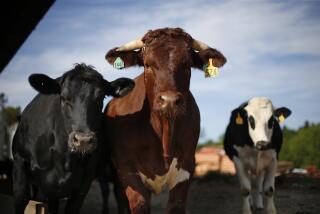Fatter cows, sicker people
- Share via
When the U.S. Food and Drug Administration restricted the routine use of a class of antibiotics known as cephalosporins in livestock, it picked an easy target. The agency’s move is better than nothing, but nonetheless it is a reminder of the FDA’s achingly slow and timid efforts to wean agriculture off the overuse of important medications. Call it a tiptoe forward after a recent giant step in the other direction and a long era of standing in one place.
Eighty percent of the antibiotics used in this country are given to chicken, pigs, turkey and cattle, not because the animals are sick but to fatten them and prevent illness from sweeping through crowded pens. Evidence has been building for decades that the overuse of antibiotics in livestock has helped lead to the emergence of antibiotic-resistant bacteria, which then present a threat to human health.
In this latest move, announced last week, the FDA restricted the agricultural use of cephalosporins, which also are used to treat people for food-borne pathogens such as salmonella and E. coli. Drug-resistant salmonella already was being found more commonly in livestock. The antibiotics also are important in treating infections in children and cancer patients.
The change won’t take a huge toll on the agricultural industry. Cephalosporins accounted for less than 1% of antibiotic use in livestock, and that was before 2010, when its use dropped more than 40%.
The new rules were obviously justified, but they represented a small gesture on the part of the FDA, which has shown far more concern about the political ramifications of new restrictions than commitment to protecting the usefulness of important drugs.
Consider that this decision was announced just a couple of weeks after the FDA backed away from a long-promised proposal to ban the routine addition of tetracycline and penicillin — far more commonly used medications — to animal feed. Instead, the food safety agency announced, it would put its efforts into “promoting voluntary reform.” Earlier in 2010, the FDA issued draft guidelines, but it hardly matters. The livestock industry isn’t about to voluntarily restrain a practice that makes its work easier and cheaper. Treating resistant infections in the U.S. costs about $20 billion a year, but that’s not money spent by feedlot operators.
In the FDA’s defense, lawmakers haven’t exactly backed up the agency. For years, Congress defeated bills to limit agricultural use of the antibiotics most important to medical treatment of infections in people. It also put on hold the FDA’s original proposal, 25 years ago, to regulate the use of tetracycline and penicillin in livestock.
Antibiotics are a little like land — no one’s making a lot of new ones. Preserving the effectiveness of the ones we have should take precedence over fattening pigs.
More to Read
A cure for the common opinion
Get thought-provoking perspectives with our weekly newsletter.
You may occasionally receive promotional content from the Los Angeles Times.









